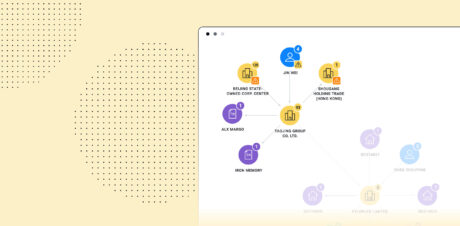The two approaches to supply chain mapping
Supply chain mapping is the process of creating a comprehensive overview of the companies and individuals in an organization’s supplier network for the purpose of driving supply chain resilience. This process helps ensure smooth, uninterrupted operations, regulatory compliance, and reputational risk mitigation.
A common way to look at approaches to supply chain mapping is inside-out versus outside-in. Inside-out mapping involves supplier-validated data, while outside-in mapping leverages publicly-available/publicly-sourced data.
Inside-out supply chain mapping: the pros and cons
Inside-out mapping collects self-reported data from the supplier, typically via a cascading request for information (RFI) or similar questionnaire. Organizations send their Tier 1 suppliers an RFI, requesting data on their direct suppliers (Tier 2), and the RFI is cascaded upstream. The goal is for this process to proceed until the raw material producer is identified. Relationships can be drawn based on this self-reported data, enabling organizations to identify upstream suppliers and adjust their maps accordingly.
Using an inside-out approach can benefit organizations because:
- Validating information directly with suppliers often produces highly accurate results as suppliers can detect nuances not available or apparent to the requesting organization (or exposed in public records).
- The process of engaging directly with suppliers to gather information can foster better communication, collaboration, and trust. This can result in a better long-term business relationship and increased loyalty between an organization and its suppliers.
Drawbacks of an inside-out approach include:
- Response rates to RFIs and similar questionnaires can be as low as 40 percent, leaving organizations with gaps in data.
- The RFI process is very resource intensive, as it relies on repeated supplier outreach, validation, and verification of supplier responses.
- There can be delays in RFI responses. It may take several weeks, if not months, to identify upstream suppliers beyond Tier 1, and an organization’s supply chain may have even changed in this time. RFI responses represent a point-in-time view, meaning organizations must repeat this process periodically to ensure data freshness.
- The strength of supplier relationships wanes beyond Tier 1 suppliers, making it more challenging to obtain data as the process moves upstream. Suppliers further upstream may be reluctant to share data for fear of being cut out of the supply chain or of disclosing competitive information.
- As with any survey, respondents may encounter poor questionnaire design, the questions can be prone to misinterpretation, and data may be incomplete. For example, your sub-tier suppliers are unlikely to disclose a sourcing relationship in Xinjiang.
Relying exclusively on an inside-out approach to supply chain mapping leaves organizations vulnerable to both information blind spots and delays that hamper business operations.
>> Learn best practices for investigating your sub-tier suppliers <<
Outside-in supply chain mapping: the pros and cons
Outside-in mapping uses information sourced outside the supplier organization to draw connections between suppliers based on shipments traded between entities. This approach typically involves use of an automated solution to ingest and analyze the data and map the supply chain.
Benefits of an outside-in approach include:
- Access to a larger dataset that is more reliable and objective.
- The mapping process is quicker and more affordable because it’s less reliant on manual effort.
- Resulting data can help fill in gaps from self-reported data, helping organizations ask smarter questions and be more targeted in applying manual auditing resources.
- Automation allows for continuous monitoring to identify changes and surface red flags.
The drawbacks of an outside-in approach include:
- The results are not guaranteed to speak to an organization’s specific supply chain. For example, an organization’s supplier has imported cotton made with forced labor and exported cotton shirts to the organization. However, it’s possible these shirts were not made with the forced-labor cotton.
- The supply chain networks mapped by an automated solution are only as good as the source trade data. If there are limitations with the source data, there will be gaps in the reported results.
>> Discover how a leading manufacturer isolated critical risks in their supply chain <<
Why outside-in mapping is critical to your supply chain
Relying solely on an inside-out view of a supply chain results in extremely long implementation timelines, the potential for data gaps, and a very slow time to value.
To obtain the most comprehensive supply chain view, organizations should pair the inside-out and outside-in approaches. A best practice is to leverage outside-in technology to automatically map and identify upstream suppliers, allowing analysts and compliance teams to batch screen these suppliers for potential risk. Then, teams can limit manual data collection efforts and reduce cost by following up only on high-priority cases where additional information is required for risk adjudication.
Sayari Map complements your supplier system of record solution and inside-out data collection so you can better understand the suppliers that matter. Our automated data gathering delivers highly accurate, evidence-based maps to accelerate your supply chain risk management process and validate your questionnaire data. Map turns billions of trade relationships into dynamic supply chains using market-leading/comprehensive data, including real trade data from 70+ countries. Map surfaces possible exposure to dozens of risk types, including forced labor and ESG. Our AI-enabled product blueprint technology isolates sub-tier suppliers of interest, helping you filter out the noise so you can build comprehensive risk adjudication and monitoring workflows to help you move forward.
Request a personalized demo of Sayari to see how you can use outside-in insights to radically enhance your supply chain transparency.



